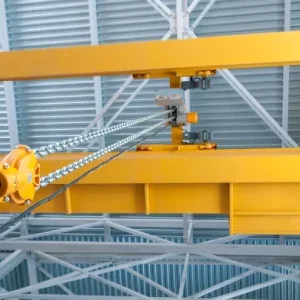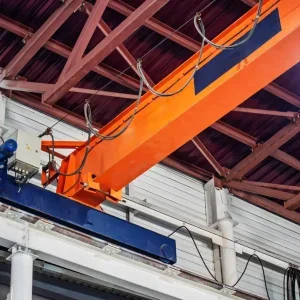Since 2003, family-owned firm Handel Sollevamenti (Handel Lifting) has been engineering pillar and wall slewing jibs, bridge cranes, sling chains, cables, and lifting accessories in its factory in Porcia, Italy. Il Cantere in Fiume Veneto recently commissioned a hoist to lift and rotate its moulds.
The moulds are used for casting Ductal cement into structures to be used for interior design. This unusual cement has eight times the strength of concrete and an elasticity that allows it to take on the textures of wood.
However, the moulds which will hold the liquid cement are fragile structures of Ductal, wood, rubber, resin, steel, polycarbonate, and plastic. Each unique mould must be lifted and transported to different workstations within the production facility so that pieces can be laid on in the right position for drying and casting can be removed. An overhead travelling chain hoist is required to lift and handle the moulds.
Handel Sollevamenti designed a double girder system using a cable-chain track and travelling hoist operated by radio remote control. The technical planning of the project after an initial analysis involved 3D modelling to verify the dimensions and the aesthetics before the draft was approved by the client.
Handel set to work with passion and dedication. Led by Gian Pietro Alcide, the lead engineer, the team constructed the beams and the lifting clamp.
“The clamp is able to rotate the mould 360 degrees around its centre of gravity. The accessory can support having telescoping moulds ranging in size from 4800mm to 2800mm,” says Federico Alcide, sales manager at Handel Sollevamenti.
The quality of the steel and the welds was inspected and the beams were painted. The team carefully checked the actual gauge in order to achieve 1mm tolerance, although the magnitudes given were high.
The company contracted Verlinde to supply the VT2 electric chain hoist and cylinder heads and Thiele to supply the chains. The project began in June 2010 and finished 30 days later. The Verlinde chain hoist was delivered 2 weeks afterward.
The bridge span on the finished hoist is about 30m, with 40m-long runways. The lifting capacity of the hoist is 5t and the maximum lifting height is 9m.
The hoist is silent, fast, and has a sag of only 11mm when fully loaded, because the structure is built in S355 (ex Fe510) unalloyed structural steel. “The crane turned out to be very versatile and silent, and also means we have the possibility of using higher speeds,” said Rivenotto.
The versatility and smoothness of the crane’s movement prevents the moulds from breaking. Alcide said, “Their product is very fragile, so you have to take into account not just weight but also the kinematic motion triggered and the rotation of the moulds.”
Alcide says that there is a growing market for specialised hoist systems using quality components. “Business has improved because we have focused on quality partners such as as Verlinde (supplier of hoists), Redaelli Tecna Division Teci (ropes) and Thiele (chains). The product provided to our clients is the result of accurate solutions designed in a personalised way.”






